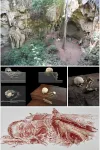German entomologist Phillip Hoenle had discovered the ant, which he noted had some peculiar features, in a rain forest in Ecuador. Now he wanted Booher, a research associate in the Yale Center for Biodiversity and Global Change and the Department of Ecology & Evolutionary Biology, to confirm whether this trap ant was truly a new species. If so, Hoenle and Booher would have the honor of naming it.
Booher had imagined this moment for years. He had even discussed it with an old friend from Athens, Georgia, the artist and former R.E.M. singer Michael Stipe. After receiving the specimen he reached out to Stipe.
"I'm going to name it after Jeremy," Booher said.
Naming a species after Jeremy Ayers was an odd choice. But then Ayers was as unusual as the smooth and shining cuticles and large trap jaw mandibles of the ant that would come to bear his name.
By the early 1970s, Charles "Jeremy" Ayers, the son of a civil rights advocate and religion professor at the University of Georgia, had found the 15 minutes of fame promised by artist and film director Andy Warhol. Working with Warhol, the potentate of New York's pop art scene, Ayers morphed into Silva Thin, one of Warhol's legion of "Superstars" who through elaborate makeup, unusual dress, and exaggerated poses, blurred gender boundaries in the city's avant-garde scene.
The Warhol Foundation still owns portraits of the ultra-slender Thin, with exaggerated eyebrows painted black, ruby red lipstick, dark mascara over the eyes, dressed in silk shirt and tie, languorously waving a cigarette.
In the late 1970s, Ayers returned to his hometown of Athens and helped give birth to a thriving artistic community that spawned some of the most popular American bands of the 1980s, including the B-52's and Stipe's R.E.M. Nestled in the deep South, the college town nurtured a post-Bohemian art scene that drew poets, sculptors, and musicians. The community also welcomed straight, gay, lesbian, and transgender people long before LGBTQ entered the popular lexicon.
And Ayers, philosopher, multi-media artist, and political activist, was the creative straw that stirred this rich stew of creative talent, one person at a time, Stipe recalls.
Stipe and Ayers became close friends; Ayers even wrote songs for R.E.M. So taken with Ayers was Stipe that he asked Ayers to dance to a musical piece he created. In the video, Jeremy's Dance, Ayers moves with awkward purpose and a total lack of self-consciousness to Stipe's synthesized beat. The video was shown at Moogfest, in 2016, soon after Ayers unexpected death following a seizure. He was 68.
"His curiosity for every single person he ever met was the foundation of a fascinating and cross-cultural network of friends, acquaintances, and colleagues, often with Jeremy at the very center of several overlapping colonies," Stipe recalled. "He created the salon, laid the trails; he was the connector, the queen ant if you will, the bringer-togetherer."
Studying -- and celebrating -- the diversity of life
The allure of Athens' creative scene also captured Douglas Booher.
He arrived in 1993 and earned a bachelor's degree at the University of Georgia, where he studied ecology. He always had a love of nature's biodiversity, but eventually dropped his pursuit of a Ph.D. (he was studying the sexual selection and mating practices of the eastern bluebird) to become a building contractor.
For the next 12 years he built his own flooring company, which manufactured and designed custom carpets and installed wood products from demolished buildings. On weekends, however, Booher transformed into DJ cut-a-rug, a disc jockey and performance dancer who, along with his artistic partner, The Big Nastee, led explosive dances late into the Georgia night. One of their performances was memorialized in this video, shot in Jeremy Ayers' garden.
But his love of the natural world never waned. One evening he joined Stipe on a visit with Ayers, who was excited to share a book with Booher. "He knew I loved insects and he had recently bought a book on the Chinese culture of keeping crickets for their sounds," Booher recalled. "He was also endlessly fascinated with nature. He knew it would bring me joy."
The act defined Ayers, who always saw the individual amidst the great diversity of his community.
"He gave people the freedom to be who they wanted to be," Booher said.
By 2012, Booher decided he wanted to pursue a career in entomology, the study of insects. He completed his Ph.D. in ecology and evolutionary biology at UCLA, where his dissertation was on the structure and assembly of ant communities.
Last year, he joined the Yale Center for Biodiversity and Global Change as a postdoctoral associate in the lab of biologist Walter Jetz. Like Ayers' embrace of members of the Athens' art scene, the goal of the Jetz lab was to explore the global diversity of life, one species at a time, he said.
In the case of the new ant found in the forests of Ecuador, its large trap jaw mandibles and shining and smooth cuticles set it apart from more than 850 species of its genus, Strumigenys, Booher determined. This was a new species. And tradition allows the discoverers to name newly discovered life.
Booher and Stipe already knew what they wanted to do. Booher discussed the issue with Hoenle, who agreed that Ayers was a worthy designee. They considered the name Strumigenys ayers.
But knowing that Ayers would shy away from an honor that was solely personal, they wanted to find a name that would also honor the many people across the gender diversity spectrum who he so often championed.
"Naming species in honor of people is a centuries old tradition among taxonomists," Hoenle said. "To honor someone means to respect their self-identity, and gender is part of that."
As it happened, in 2007 a publication clarified that the International Code of Nomenclature did not require that new species carry Latin suffixes based on the gender of the individual being honored. So rather than using one of the traditional Latin suffixes -- either ae, which designates a female, or i for a male, or orum for a group of male and female individuals -- Booher and Stipe adopted a new suffix that recognizes non-binary individuals and honors the spirit of Ayers, an activist who had always fought for, celebrated, and honored the diversity of life, including those gender diverse individuals who didn't fit neatly into a binary category.
They named the ant Strumigenys ayersthey.
"I knew Jeremy, and knew of no other human that better represented the pan and inclusive world of humans," Booher said. "He was also a lover of biodiversity, so it just seemed to fit."
INFORMATION:
The study on the new species was published in the open-access, peer-reviewed scientific journal ZooKeys.







